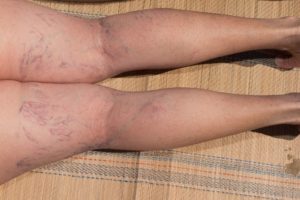 Varicose veins are often harmless and don’t cause symptoms aside from being unsightly to look at. But in some cases, varicose veins can lead to dangerous health problems, especially if left untreated.
Varicose veins are often harmless and don’t cause symptoms aside from being unsightly to look at. But in some cases, varicose veins can lead to dangerous health problems, especially if left untreated.
When a person does experience symptoms related to their varicose veins, they often experience heaviness in the legs, burning, itching, aching, and swelling. In some cases, varicose veins may bleed, or blood clots may develop.
Advertisement
If you experience early symptoms of varicose veins, it’s essential that you seek out medical attention to reduce your risk of health complications. Some of those remedies include using compression stockings, being more active, avoiding prolonged standing or sitting, or even a simple outpatient procedure.
Here are six health problems that are associated with untreated varicose veins.
6 Dangers of Untreated Varicose Veins
Hyperpigmentation: In varicose veins, blood can pool, causing deoxygenation and a lack of nutrients, which can trigger chronic inflammation. This can result in the skin becoming discolored and dark. Symptoms associated with hyperpigmentation include swelling, throbbing, itching, aching, and burning.
Lipodermatosclerosis: This condition affects the skin of the lower legs. Symptoms include pain, hardening of the skin, changes in skin color, swelling, and tapering of the legs above the ankles.
Venous leg ulcers: Venous ulcers, or open sores, can occur if the blood in the legs is not pushed back up to the heart, causing blood to pool, which can lead to excess fluid pushing through and cause an open sore. These sores are most common above the ankle, and if left untreated, it can lead to infection. Medical attention is strongly advised in order to reduce the risk of complications or even death.
Spontaneous bleeding: There is a risk of spontaneous bleeding when the skin over the veins becomes thin, and swelling adds pressure to the veins, which increases their risk of injury and bleeding. Even the most straightforward task of putting on clothes or grazing another object is enough to cause bleeding.
Advertisement
Superficial thrombophlebitis: This is inflammation of the vein just below the surface of the skin. Blood clots are more likely to develop below the surface of the skin. Symptoms include redness of the skin, firm, tender, or warm veins, and localized leg pain.
Deep vein thrombosis: This is a blood clot in a vein deep inside the body. This is dangerous because if the blood clot breaks off, it can travel to the lungs or even brain, increasing the risk of a more serious medical problem. Changes in the legs should be reported immediately to determine if a clot is present or not to reduce the risk of a serious health outcome.
Also read:
- Healthy veins: Natural ways to avoid venous insufficiency
- Varicose veins natural treatment: How to get rid of spider veins naturally
